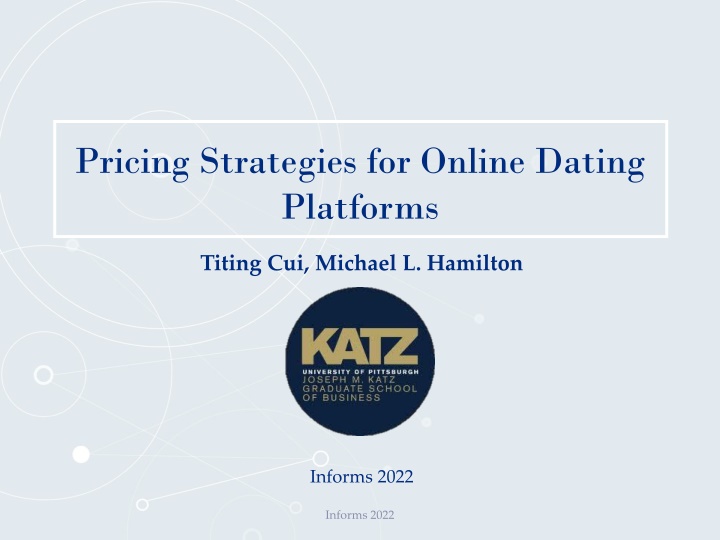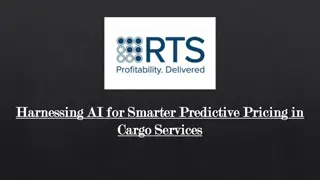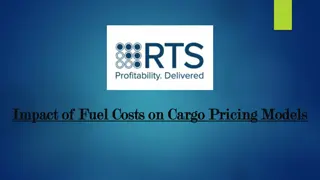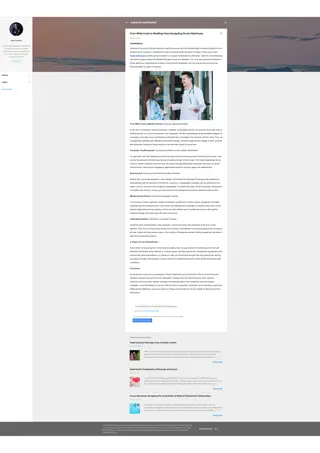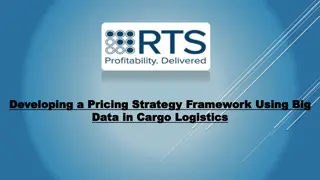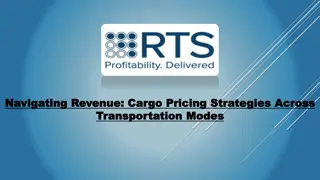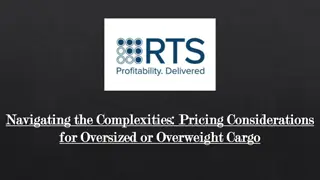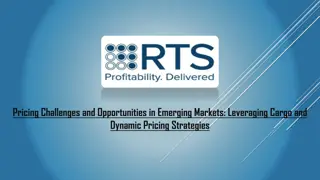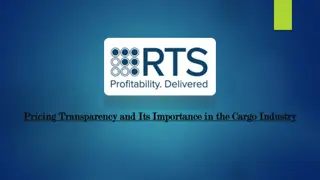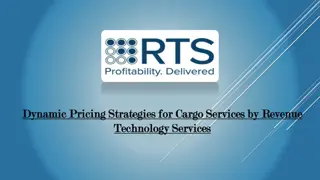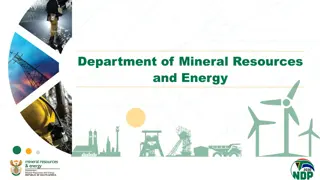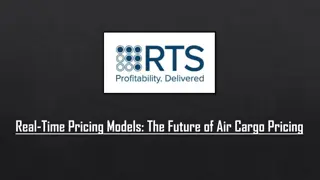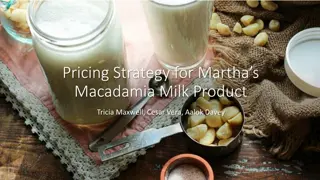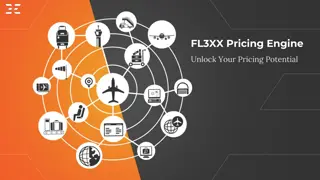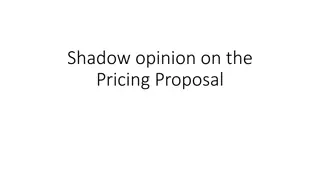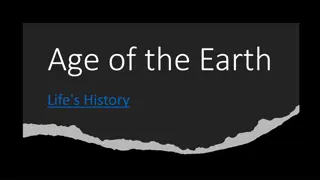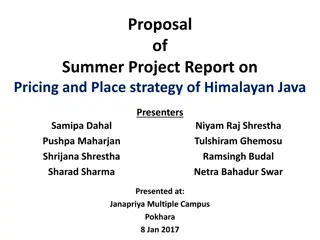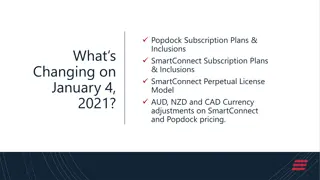Pricing Strategies for Online Dating Platforms
Online dating platforms have seen significant growth in revenue, displacing traditional meeting mediums. This study delves into subscription set-up, revenue maximization, and welfare optimization for swipe apps like Tinder, Bumble, and Hinge. It explores revenue models, cost analysis, and the impact of user preferences on pricing strategies.
Download Presentation

Please find below an Image/Link to download the presentation.
The content on the website is provided AS IS for your information and personal use only. It may not be sold, licensed, or shared on other websites without obtaining consent from the author.If you encounter any issues during the download, it is possible that the publisher has removed the file from their server.
You are allowed to download the files provided on this website for personal or commercial use, subject to the condition that they are used lawfully. All files are the property of their respective owners.
The content on the website is provided AS IS for your information and personal use only. It may not be sold, licensed, or shared on other websites without obtaining consent from the author.
E N D
Presentation Transcript
Pricing Strategies for Online Dating Platforms Titing Cui, Michael L. Hamilton Informs 2022 Informs 2022
Online Dating Online dating platforms revenues have swelled over the last five years, with an annual growth rate of 12.9%, rising to $5.3 billion as mobile services expand. Informs 2022
Online Dating Online dating platforms have displaced conventional mediums such as family, school, or the workplace, to become the most common way for new couples to meet. Informs 2022
Online Dating in Practice Bumble Hinge Informs 2022
Outline/Expectations Qu: What is the right subscription set-up for online dating apps? What maximizes revenue? What maximizes welfare? Simplifying Assumption: We focus on swipe apps Users swipe left or right on candidate partners. No searching. Dominant paradigm: Tinder, Bumble, Hinge etc. Simplifying Assumption : Users are looking for love A match will be a permanent pairing after which users leave the site No short term or casual dating in our model. Simplifying Assumption : One subscription option Strategy space is a subscription period length and price pair Informs 2022
Contributions C1: Derive revenue bounds for subscription models (Thm. 1). We give a novel model to describe the pricing for online dating platforms and prove bounds on the profit ratio of freemium pricing to the optimal achievable profits. C2: Fine-grained analysis for cost and matching proportion (Thm. 2 & 3). When the marginal operating cost, c, is small, we show longer subscription periods are better for profit and increase the match rate! C3: Extensions to heterogenous matching rate (Thm 4). When the platform strategically varies the match rate, (FP) has the incentive to offer users the worst matches while (CP) s incentive is to match the user as quickly as possible. Informs 2022
Model: ODP User: ?: User s valuation/WtP for a match follows distribution V~?, ?: Valuation/WtP decays at a constant rate ? (0,1), ??= ??? Note: This is valuation of app service. 61% of Hinge users feel overwhelmed by modern dating process Four in five report some degree of burnout Informs 2022
Model: ODP User: ?: User s valuation/WtP for a match follows distribution V~?, ?: Valuation/WtP decays at a constant rate ? (0,1), ??= ??? Platform: ?,?: Online dating platform offers price ? for using the platform for a period of length ?. ?: The unit operating cost for providing services is ?. ?: For each period, users match with probability 1 ? ??. Note: Swipe apps are discrete. Match with small probability ~q, see T(L) people a period Should be geometric, we smooth it to trunc. exponential Informs 2022
Model: ODP User: ?: User s valuation/WtP for a match follows distribution V~?, ?: Valuation/WtP decays at a constant rate ? (0,1), ??= ??? Platform: ?,?: Online dating platform offers price ? for using the platform for a period of length ?. ?: The unit operating cost for providing services is ?. ?: For each period, users match with probability 1 ? ??. ? ?,? = ?? ??????? ?? ???????? ??[???? ?? ????????] ? ? = ???? ? ?,? Informs 2022
Online Dating Platform Example 2 1 Price: ? Valuation: ?1 Revenue: 0 Cost: 0 Informs 2022
Online Dating Platform Example 2 1 Price: ? Valuation: ?1 Revenue: p Cost: 0 Informs 2022
Online Dating Platform Example 2 1 Prob: 1 ? ?? Price: ? Valuation: ?1?? Revenue: ? Cost: ?? Informs 2022
Online Dating Platform Example 2 1 Price: p Valuation: ?1?? Revenue: 2? Cost: ?? Informs 2022
Online Dating Platform Example 2 1 Price: p Valuation: ?1?? Revenue: 2? Cost: ?? + 0.5?? Informs 2022
Special Cases of ODP Freemium Pricing (FP) (? ?) Free The platform s expected profit is ????,? = ? ? ? ???? ?? ???????? ?,?,?,? Note: Monetization here can be thought of as from ads, selling metadata, etc. Price is intensity at which ads are shown. Contract Pricing (CP) (? ) The platform s expected profit is ????, = (? ?? ???? ?? ???????? ?,?,?,? )??(??[??] ?) Informs 2022
Q1: Why Short Subscriptions? Theorem 1 [Freemium Pricing is Approximately Optimal]. For all positive valued distributions ?, parameters ?,? > 0, and ? (0,1) , then: ??? max ? 1 ?(?) 1 + ? Takeaway No other period length achieves constant factor for all market params. Freemium pricing is robust + easy to implement Often more than 1/(1+e)! Close to 1 when ? is close 1 Informs 2022
Q2: Impacts of Costs? Theorem 2 [Profit Relationships as Cost Varies]. For all positive valued MHR distributions ?,parameters ? and ? (0,1) , and for all ? : When ? = 0, RCP ?(?). Takeaway When marginal operating cost ? is low, longer payment period is better. Often small in online dating markets! FP and CP both have interesting properties we will focus on them. Informs 2022
Q2: Impacts of Costs? Example of Theorem 2 [Profit Relationships as Cost Varies]. ? = 0.8,? = 0.2,? = 7,? = ???(1) Informs 2022
Special Cases of ODP Freemium Pricing (FP) (? ?) Ads! Great initial policy Easy to implement, just run ads Pro: Robust Contract Pricing (CP) (? ) Requires commitment from users to implement Pro: Optimal when costs are low! Informs 2022
Q3: Matching Proportion? Definition: Let ?(?) be the proportion of the market that ultimately gets matched under the profit-maximizing price. Theorem 3 [Match Proportion Dominance]. For all positive valued MHR distributions ?,parameters ?,?, ? (0,1) , and when log 1/? ? , ? is sufficiently small: ??? ??? Takeaway When marginal cost is low, longer payment period also benefits users. Low cost means more profit AND more welfare (match proportion) from longer payment periods Informs 2022
Q3: Matching Proportion? Example of Theorem 3 [Match Proportion Dominance] ? = 0.8,? = 0.2,? = 7,? = ???(1) Informs 2022
Thm. 2 + Thm. 3 Revenue and Match Proportion Dominance --- (FP) (CP) Match Proportion (M) Revenue (R) Cost (c) ? = 0.8,? = 0.2,? = 7,? = ???(1) Informs 2022
Q4: Heterogenous Matching Rates? Generalization: Assume there are ? possible matching rates {?1, ,??} , where ?1 ?2 ?? Theorem [Strategic Matchmakers]. For all positive valued, MHR distributions ?,parameters ?,? > 0, and ? (0,1), Within each period, the match rate ordering is decreasing Between periods, the average match rate is increasing Takeaway (CP) aligns the incentives of platforms and users. (FP) misaligns the incentives of platforms and users. Informs 2022
Conclusions ODP Freemium Pricing (FP) (? ?) Ads! Great initial policy Easy to implement! Pro: Robust Contract Pricing (CP) (? ) Pro: Optimal when costs are low! Pro: Matches a higher proportion of the users! Pro: Users are incentivized to provide information, translates to lower prices, higher profit, better served market! Informs 2022
Thank you! https://papers.ssrn.com/sol3/papers.cfm?abstract_id=4032735 New version coming soon! Comments, questions tic54@pitt.edu More papers: https://tcui-pitt.github.io/, https://mhamilton-pitt.github.io/ Informs 2022
